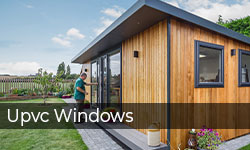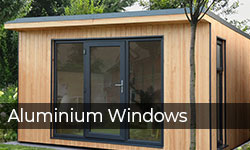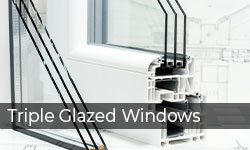
uPVC Windows
uPVC Windows
The classic and most recognisable window material for generations, uPVC windows blend in with most styles of home thanks to the wide colour palette applicable and inherent flexibility. uPVC is also the most visually versatile of the options available. While hardwood and aluminium come in different colours and finishes, uPVC can be completely customised to match any homeowner taste or the style of any property.
uPVC is not just relatively cost-effective but offers quicker manufacturing times too. Virtually no maintenance, uPVC provides a practical and durable window solution that can work well on a huge range of properties. They’re a British property staple, offering reliable security, efficiency, and style at an affordable price point. uPVC windows always provide homeowners with a ‘set and forget’ window solution. They’re wholly resistant to harsh weather conditions and are easily recycled at the end of their long lifespan.
What’s more, at a time when more and more of us are keen to cut both our energy bills and our impact on the environment, uPVC is winning fans for its exceptional thermal performance. It excels at keeping heat in, draughts out, and interior spaces peaceful and quiet. Making uPVC products a fantastic choice if you live near a busy road.
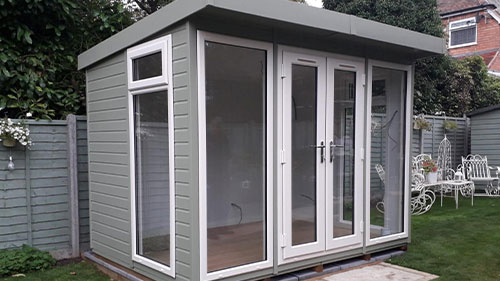
What are uPVC windows?
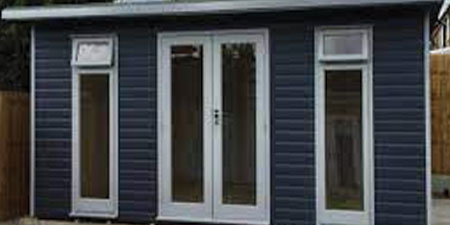
uPVC stands for unplasticised polyvinyl chloride. uPVC window frames comprise of a multi-chambered profile, which incorporates numerous layers and innovative chambers. This specification actively retains the warmth inside of the room, whilst stopping any cold elements from entering. The multi-layered design also means it’s a robust and durable material that will keep your home safe and secure. Benefiting from modern manufacturing techniques, it can be shaped in a range of functional designs, including casement, tilt and turn and even bespoke window designs.
uPVC window performance overview
- Low maintenance and easy to clean
- High thermal performance: 0.8 U-Value
- A energy rating
- Available in modern and classic styles
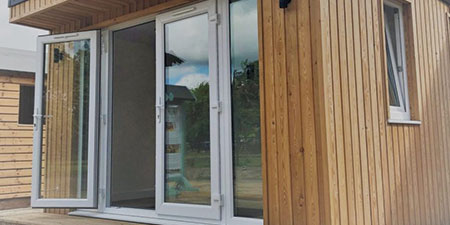
What are the disadvantages of uPVC windows?
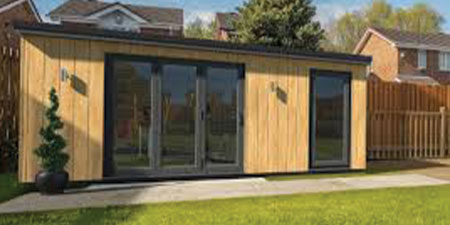
Although uPVC windows are incredibly versatile, they don’t suit all property styles, such as those that require the slender sightlines of aluminium. Aluminium is also much stronger than uPVC and can last up to 45 years with little to no maintenance. Lasting between 20-30 years, modern uPVC windows are strong but not as strong as aluminium. And, although uPVC windows come with a wide colour palette to choose from, aluminium windows are available in 150 RAL colours.
uPVC Window Benefits
Aluminium Window Benefits
Low maintenance
Low maintenance
Cheapest choice
Slimline frames
Thermally efficient
Superior thermal performances
Durable and robust
Strongest construction material
Versatile designs
Long lifespan
Aluminium or UPVC Windows, Which is Best?
Both are excellent! Aluminium windows always cost a little bit more than UPVC, but window prices aside there is little difference in terms of their performance. Some people think that the aesthetics of aluminium are better but UPVC or aluminium windows are both top materials for new or replacement windows.
We specialise in guiding our clients to the perfect window choice for their needs, so you can be certain we will find the right materials for your project in the south coast region of the UK.
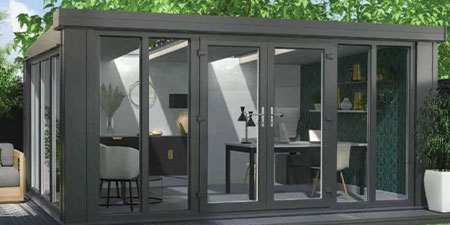
Aluminium or UPVC Windows, Which is Best?
Casement windows
Chances are you have casement windows in your house; they are side hinged openers set in a framework with a sill.
Like in your house casement windows are a good option for a garden office. They come in different sizes and styles – plain, with bars etc., and offer a real benefit in that you can easily open them to ventilate the room.
Casement windows also work well in a garden office because they can be positioned over the desk area, giving you a view to gaze out at as you work! The fact that furniture can easily be positioned below and around casement windows maximise the working space. Which can be a problem when choosing floor to ceiling glazing options.
Casement windows are typically found on the more traditional garden office styles, with contemporary garden office designers favouring larger expanses of glass.
Floor to ceiling windows
Floor to ceiling glazing has become a significant trend in garden office design. We can understand why, because it enables a connection of the inside space with the garden. Its this connection with the outdoors which appeals to many garden office owners.
Floor to ceiling windows come in all shapes and sizes and are used in different positions by different suppliers. The common trend is to create whole walls of glazing by mixing large fixed floor to ceiling windows with a set of doors.
Because floor to ceiling glass is usually fitted in one piece, so there are no bars breaking up the visual line. They are normally fixed, i.e. non-opening windows, and this can pose an issue with getting air into the room. There are some days when you just want a window ajar for a little air, but your only option would be to open the door which could be too much!
Garden office designers get around this issue by either designing opening sections in their glazed walls, although they are not keen on this because the framework for an opening window breaks the clean visual line. Or, they include smaller opening windows elsewhere in the building or even opening roof windows.
Wrap around windows
Wrap around glazing is a favourite feature in garden office design, as it creates a real connection of inside-outside space and floods the room with natural light.
Depending on the design of the building the glazing can wrap around two elevations or even three. When the glazing wraps around the building like this the structure of the roof appears to float on the glazing – rest assured a lot of engineering goes into ensuring that the weight of the building isn’t going through the glass!
Wrap around glazing takes two forms; the most common is floor to ceiling fixed glass panels which are mixed in with door systems to create glazed walls. The other option is desk height wrap-around glazing.
Desk height wrap-around glazing is a clever option as it maximises the internal space for office furniture, e.g. desks, shelving etc., but also maximises the glazing in the area you are working. Creating a cockpit-like setup. Which makes you feel, as you are sitting at your desk, that you are part of the garden.
Desk height wrap-around glazing tends to be a combination of fixed glazed panels and top hung (awning) windows which allow you to control the ventilation in the room.
Narrow rectangular windows
Narrow rectangular windows are also known as lozenge or letterbox windows. We are seeing them used in garden office design more and more. Rectangular windows tend to be used with other styles of glazing such as floor to ceiling windows and are useful as high-level glazing or desk height glazing.
Although some rectangular windows are fixed, i.e. they don’t open. Most examples we have seen are top hung awning windows. This is very useful, particularly when combined with large expanses of fixed glazing as they are easy to open allowing you to control the air flow in the building.
Cathedral windows
Pitched roof garden office designs open up the possibility of including high-level glazing in your design. High-level glazing floods your room with natural light.
With dual pitched garden offices the gable ends can be glazed to great effect. By combining long windows with glazing in the gable end, a cathedral style window can be created.
Porthole windows
A couple of traditional style garden office suppliers offer the option of round windows, often called portholes they resemble the windows on a boat. These round windows can be positioned at standard window height, but are more often positioned in the gable end of the building creating high-level glazing.
Porthole windows come in both fixed, non-opening options and opening windows which are a good ventilation source.
Cathedral windows
Pitched roof garden office designs open up the possibility of including high-level glazing in your design. High-level glazing floods your room with natural light.
With dual pitched garden offices the gable ends can be glazed to great effect. By combining long windows with glazing in the gable end, a cathedral style window can be created.
Roof windows
You’re not limited to just placing windows in the walls of your garden office; the roof can provide a source of good light and an extra ventilation point.
There are lots of different styles of roof window used in garden office design, the most common is the opening roof window like those you’ll find used in loft conversions. This type of window used in a pitched roof design can flood the room with natural light, and they are easy to open. Extras such as remote controls, rain sensors to close the windows and blinds can be easily ordered.
On flat roof garden offices roof lanterns are often used, they can be dome-shaped or four-sided pyramid units. Some designs have opening vents; others are fixed units.






